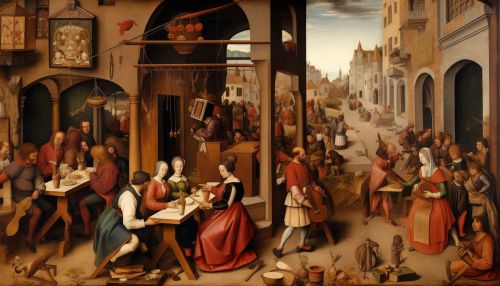Renaissance man
Definition and Origin
A Renaissance man is a term that originated from the historical era of the Renaissance, a period of significant cultural and intellectual expansion in Europe from the 14th to the 17th century. The term is used to describe an individual who has acquired profound knowledge or proficiency in more than one field. These fields typically span both the arts and the sciences, reflecting the broad spectrum of human knowledge and creativity.
Historical Context
The concept of the Renaissance man emerged during the Renaissance, a period marked by a renewed interest in the knowledge of the ancient Greeks and Romans. This period saw a shift from the religious orthodoxy of the Middle Ages to a more human-centric worldview, often referred to as humanism. The humanists of the Renaissance believed in the potential of humans to achieve excellence in a wide range of fields, leading to the ideal of the "universal man" or the "Renaissance man".


Characteristics
A Renaissance man is characterized by their wide-ranging knowledge and skills across multiple fields. This includes, but is not limited to, the arts, sciences, social sciences, and humanities. They are often fluent in multiple languages, well-versed in literature, skilled in the arts, knowledgeable in the sciences, and adept at physical activities.
The Renaissance man is also characterized by their curiosity, creativity, and desire for continuous learning. They are not content with specialization in a single field but strive to expand their knowledge and skills across a wide range of disciplines.
Notable Figures
There have been many notable figures throughout history who exemplify the concept of the Renaissance man. Perhaps the most famous is Leonardo da Vinci, an Italian artist, scientist, engineer, and inventor, among other things. His diverse interests and talents epitomize the ideal of the Renaissance man.
Other notable figures include Michelangelo, an Italian sculptor, painter, architect, and poet; Galileo Galilei, an Italian astronomer, physicist, and engineer; and Benjamin Franklin, an American polymath who was a leading author, printer, political theorist, politician, freemason, postmaster, scientist, inventor, humorist, civic activist, statesman, and diplomat.
Modern Interpretation
In the modern context, the term "Renaissance man" is often used to describe individuals who have wide-ranging interests and talents across multiple fields. While the term originally referred to individuals who excelled in both the arts and sciences, it has since been expanded to include any individual who demonstrates proficiency in multiple disciplines, regardless of whether these disciplines fall within the traditional categories of arts or sciences.
Criticism and Controversy
The concept of the Renaissance man has been subject to criticism and controversy. Some argue that the ideal of the Renaissance man is unrealistic and unattainable, given the vast amount of knowledge and the degree of specialization required in modern society. Others argue that the concept is inherently gendered, as it is based on the ideal of the "universal man" and often excludes women and other marginalized groups.
Conclusion
The Renaissance man represents an ideal of human potential and achievement. While the concept has its roots in the historical era of the Renaissance, it continues to resonate in the modern world, reflecting the enduring human desire for knowledge, creativity, and excellence in multiple fields.
